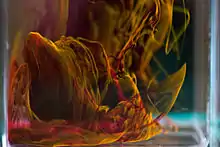

Rhodamine /ˈroʊdəmiːn/ is a family of related dyes, a subset of the triarylmethane dyes. They are derivatives of xanthene. Important members of the rhodamine family are Rhodamine 6G, Rhodamine 123, and Rhodamine B. They are mainly used to dye paper and inks, but they lack the lightfastness for fabric dyeing.[1]
Use
Aside from their major applications, they are often used as a tracer dye, e.g. to determine the rate and direction of flow and transport of water. Rhodamine dyes fluoresce and can thus be detected easily and inexpensively with instruments called fluorometers. Rhodamine dyes are used extensively in biotechnology applications such as fluorescence microscopy, flow cytometry, fluorescence correlation spectroscopy and ELISA. Rhodamine 123 is used in biochemistry to inhibit mitochondrion function. Rhodamine 123 appears to bind to the mitochondrial membranes and inhibit transport processes, especially the electron transport chain, thus slowing down cellular respiration. It is a substrate of P-glycoprotein (Pgp), which is usually overexpressed in cancer cells. Recent reports indicate that rhodamine 123 may also be a substrate of multidrug resistance-associated protein (MRP), or more specifically, MRP1.
In addition to their major applications, rhodamines are used in dye laser as gain media.[2][3]
Other derivatives
There are many rhodamine derivatives used for imaging purposes, for example Carboxytetramethylrhodamine (TAMRA),[4] tetramethylrhodamine (TMR) and its isothiocyanate derivative (TRITC) and, sulforhodamine 101 (and its sulfonyl chloride form Texas Red) and Rhodamine Red. TRITC is the base rhodamine molecule functionalized with an isothiocyanate group (−N=C=S), replacing a hydrogen atom on the bottom ring of the structure. This derivative is reactive towards amine groups on proteins inside cells. A succinimidyl-ester functional group attached to the rhodamine core, creating NHS-rhodamine, forms another common amine-reactive derivative.
Other derivatives of rhodamine include newer fluorophores such as Alexa 546, Alexa 633, DyLight 550 and DyLight 633, HiLyte fluor 555 HiLyte 594, Janelia Dyes JF549 and JF669 have been tailored for various chemical and biological applications where higher photostability, increased brightness, different spectral characteristics, or different attachment groups are needed.
Substituents of the xanthene core are influencing the properties of the xanthene dyes by both electronic and steric effects. Specifically designed substituents also allows xanthenes to bear specific functions activatable upon excitation by visible light, e.g. they could act as photoremovable protecting group for carboxylates and halides,[5] carbon monoxide (thus being a photoCORM),[6] or added as a secondary functionality of fluorescent dyes, e.g. fluorescent pH indicators.
References
- ↑ Gessner, Thomas; Mayer, Udo (2000). "Triarylmethane and Diarylmethane Dyes". Ullmann's Encyclopedia of Industrial Chemistry. Weinheim: Wiley-VCH. doi:10.1002/14356007.a27_179. ISBN 978-3527306732.
- ↑ F. P. Schäfer (Ed.), Dye Lasers, 3rd Ed. (Springer-Verlag, Berlin, 1990).
- ↑ F. J. Duarte and L. W. Hillman (Eds.), Dye Laser Principles (Academic, New York, 1990).
- ↑ Hendrickson, W. A.; Ward, K. B. (1975-10-27). "Atomic models for the polypeptide backbones of myohemerythrin and hemerythrin". Biochemical and Biophysical Research Communications. 66 (4): 1349–1356. doi:10.1016/0006-291x(75)90508-2. ISSN 1090-2104. PMID 5.
- ↑ Šebej, Peter; Wintner, Jürgen; Müller, Pavel; Slanina, Tomáš; Al Anshori, Jamaludin; Antony, Lovely Angel Panamparambil; Klán, Petr; Wirz, Jakob (2013-03-01). "Fluorescein Analogues as Photoremovable Protecting Groups Absorbing at ~520 nm". The Journal of Organic Chemistry. 78 (5): 1833–1843. doi:10.1021/jo301455n. ISSN 0022-3263. PMID 22827158.
- ↑ Antony, Lovely Angel Panamparambil; Slanina, Tomáš; Šebej, Peter; Šolomek, Tomáš; Klán, Petr (2013-09-06). "Fluorescein Analogue Xanthene-9-Carboxylic Acid: A Transition-Metal-Free CO Releasing Molecule Activated by Green Light". Organic Letters. 15 (17): 4552–4555. doi:10.1021/ol4021089. ISSN 1523-7060. PMID 23957602.
External links
- Absorption and Emission Spectra of Rhodamine B
- Absorption and Emission Spectra of Rhodamine 6G
- Absorption and Emission Spectra of Rhodamine 123
- Berlier et al. 2003 J. Histochem Cytochem refers to Alexa 633 as a rhodamine derivative.